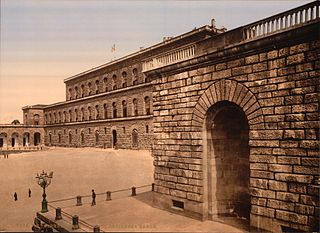
Fra Bartolomeo or Bartolommeo, also known as Bartolommeo di Pagholo, Bartolommeo di S. Marco, and his original nickname Baccio della Porta, was an Italian Renaissance painter of religious subjects. He spent all his career in Florence until his mid-forties, when he travelled to work in various cities, as far south as Rome. He trained with Cosimo Roselli and in the 1490s fell under the influence of Savonarola, which led him to become a Dominican friar in 1500, renouncing painting for several years. Typically his paintings are of static groups of figures in subjects such as the Virgin and Child with Saints.

Pietro Perugino, born Pietro Vannucci, was an Italian Renaissance painter of the Umbrian school, who developed some of the qualities that found classic expression in the High Renaissance. Raphael was his most famous pupil.

Domenico di Pace Beccafumi was an Italian Renaissance-Mannerist painter active predominantly in Siena. He is considered one of the last undiluted representatives of the Sienese school of painting.

The Palazzo Pitti, in English sometimes called the Pitti Palace, is a vast, mainly Renaissance, palace in Florence, Italy. It is situated on the south side of the River Arno, a short distance from the Ponte Vecchio. The core of the present palazzo dates from 1458 and was originally the town residence of Luca Pitti, an ambitious Florentine banker.

Giovanni Lanfranco was an Italian painter of the Baroque period.

Raffaellino del Garbo was a Florentine painter of the early Renaissance.

Ridolfo di Domenico Bigordi, better known as Ridolfo Ghirlandaio was an Italian Renaissance painter active mainly in Florence. He was the son of Domenico Ghirlandaio.

Matteo Rosselli was an Italian painter of the late Florentine Counter-Mannerism and early Baroque. He is best known however for his highly populated grand-manner historical paintings.

Vincenzo Meucci (1694–1766) was an Italian painter of the late-Baroque period. Born in Florence. He was a pupil first of the painter Sebastiano Galeotti, then of Giovanni Gioseffo dal Sole in Bologna.

Andrea del Sarto was an Italian painter from Florence, whose career flourished during the High Renaissance and early Mannerism. He was known as an outstanding fresco decorator, painter of altar-pieces, portraitist, draughtsman, and colorist. Though highly regarded during his lifetime as an artist senza errori, his renown was eclipsed after his death by that of his contemporaries Leonardo da Vinci, Michelangelo, and Raphael.

The Madonna of the Basket or the Madonna della Cesta is a painting by Peter Paul Rubens, dated to around 1615. It is now held in the Galleria Palatina of the Palazzo Pitti in Florence. Between 1799 and 1815 it was confiscated by the French and assigned to the Dijon Museum of Fine Arts.

The Peasants' Return From The Fields is a c. 1640 painting by Peter Paul Rubens. It arrived in Florence in 1765 and is now in the Galleria Palatina in Florence.

The Madonna of the Baldacchino is a c.1506-1508 oil on canvas holy conversation-style painting by Raphael, now in the Galleria Palatina in Florence.

The Disputation on the Trinity is a c.1517 oil on canvas painting by Andrea del Sarto, now in the Galleria Palatina in Florence.

The Bartolini Tondo is a tempera on panel painting by Filippo Lippi. 135 cm in diameter, it is also known as Madonna with the Child and Scenes from the Life of St Anne or Madonna and Child with the Birth of the Virgin and the Meeting between St Joachim and St Anne. It is now in the Galleria Palatina in the Palazzo Pitti in Florence. The work is mentioned in the Palazzo Pitti inventories in 1761, which mention it as being stored or displayed in the "soffitte" or attics.

Villamagna Altarpiece is a 1521 oil on panel painting by Rosso Fiorentino, produced for Pieve dei Santi Giovanni Battista e Felicita, Villamagna's parish church, where it remained until the mid 1860s. It is now in the Diocesan Museum in Volterra. The artist's second commission in Volterra after Deposition, it is signed and dated in the lower left-hand corner. To the left of the Madonna and Child is John the Baptist in his camel-skin tunic and holding a cross, whilst to the left is Saint Bartholomew holding an open book and the knife used to flay him.

Portrait of a Man in Black or Man in Black in Profile is a c.1520-1522 oil on panel painting by Rosso Fiorentino, now in the Galleria Palatina in Florence. Vasari's Life of Rosso Fiorentino briefly states that he saw several portraits by the artist in homes in Florence, probably produced before Rosso left for Volterra in 1521. How Man entered the Medici-Lorraine collections is unknown, since the first definite mention of the work is an 1815 inventory placing it in the Galleria's Sala dell'Iliade.

Adoration of the Magi is a c.1522-1523 oil on panel painting by Pontormo, produced for the antechamber of Giovan Maria Benitendi's palazzo in Florence and now in the Galleria Palatina in the same city.

Saint John the Baptist as a Boy is an oil on panel painting by Andrea del Sarto, executed c. 1525, now in the Palatine Gallery of the Palazzo Pitti in Florence.

Portrait of Cardinal Guido Bentivoglio is an oil on canvas painting of Guido Bentivoglio by Anthony van Dyck, now in the Galleria Palatina in Florence. It was painted around 1623 during the artist's stay in Italy - Bentivoglio had links to the artist's native Flanders.




















